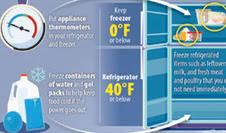

Are You and Your Food Prepared for a Power Outage?
Sep 22, 2016
Are You and Your Food Prepared for a Power Outage?
Every year, the month of September is recognized as National Preparedness Month! The purpose of National Preparedness Month is to educate Americans on planning and preparing for various types of disasters and emergencies. Weather can be extremely unpredictable, and these emergencies and disasters can happen anywhere. Even if you live in an area that doesn’t typically experience extreme weather, you may still experience occasional power outages. The USDA’s Food Safety and Inspection Service has information to help you plan and prepare for a power outage caused by a disaster or emergency.
Power outages can be inconvenient and dangerous for a number of reasons, but one of the most concerning is the safety of your food. Refrigeration is important for the prevention of bacterial growth in food. With a power outage, foods can quickly warm to unsafe temperatures. Knowing how to prepare and react to a power outage can keep foods from becoming unsafe and prevent you and your family from getting sick.
Before the Power Goes Out
- Use appliance thermometers to make sure your refrigerator and freezer are always at a temperature of 40 ºF or below for the refrigerator, and 0 ºF or below for the freezer. This will help keep food safe longer during a power outage.
- Keep ice, freezer packs, and frozen bottles of water in the freezer to keep food cold if there is a power outage.
- Keep a cooler available to fill with ice and cold foods in case of a prolonged power outage.
- Group foods together in the freezer; they will help keep each other cold.
- Freeze any perishable foods such as milk, meats, and leftovers so that they will have a better chance of staying cold and safe during power outage.
- Consider buying dry or block ice to keep the refrigerator as cold as possible during periods of prolonged power outage. Fifty pounds of dry ice should keep a fully-stocked 18-cubic-feet freezer cold for two days.
During a Power Outage
- Keep appliance doors CLOSED as much as possible. Opening and closing doors will release cold air and cause the safe storage time of perishable items to reduce.
- A fully stocked refrigerator will stay cold for about 4 hours. A freezer will keep its temperature for 24 hours if half full or 48 hours if full.
- If the power has been out for 4 hours, and a cooler and ice are available, transfer perishable foods in the refrigerator to the cooler to maintain a temperature of 40 ºF or below. Be sure to add ice or a cold source.
After Power Returns
- Check the temperature of the refrigerator and freezer. If foods in both are still under 40 ºF, they are safe to keep and/or refreeze. If the foods are above 40 ºF, they should be discarded.
- Also check foods that were in a cooler before putting them back into the refrigerator. Discard any that are over 40 ºF.
- Unsure if a food is still safe? Review these food evaluation charts that are available forrefrigerated foods and the frozen foods after a power outage.
- Discard any food that has an unusual odor, color, or texture, or feels warm to the touch.
- Never taste a food to determine its safety.
Additional Resources
If you have questions about the safety of your food, please call the USDA Meat and Poultry Hotline at 1-888-MPHotline (1-888-674-6854) or chat live with a food safety specialist at AskKaren.gov, available from 10 a.m. to 4 p.m. ET, Monday through Friday, in English or Spanish. In addition, FSIS posts food safety tips during severe weather on Twitter, @USDAFoodSafety, and on Facebook, atFacebook.com/FoodSafety.gov.
For food storage information including safe storage temperatures and times, download the USDA’s FoodKeeper App, available on iTunes and Google Play stores.
For more information about food safety in an emergency, visit:
For food storage information including safe storage temperatures and times, download the USDA’s FoodKeeper App, available on iTunes and Google Play stores.
For more information about food safety in an emergency, visit:
- A Consumer’s Guide to Food Safety: Severe Storms and Hurricanes (a manual covering all power outage related food safety topics)
- Food Safety During a Power Outage (short video)
- In an Emergency (gateway to all federal food safety resources)
- Food Safety Before, During and After A Power Outage (FSIS infographic)


































No hay comentarios:
Publicar un comentario